The ASUS Republic of Gamers G751 Review: G-SYNC Comes To The Notebook Computer
by Brett Howse on July 29, 2015 8:30 AM ESTWireless
ASUS has turned to the fairly pedestrian Intel Dual Band Wireless-AC 7260 choice, which offers 802.11ac wireless as well as Bluetooth 4.0 capabilities. Intel does offer a newer version of this in the 7265, but it is offered in less form factors, so some OEMs have kept with the older model to keep the form factor they prefer. It does offer 2x2:2 capabilities for a maximum theoretical speed of 866 Mbps.
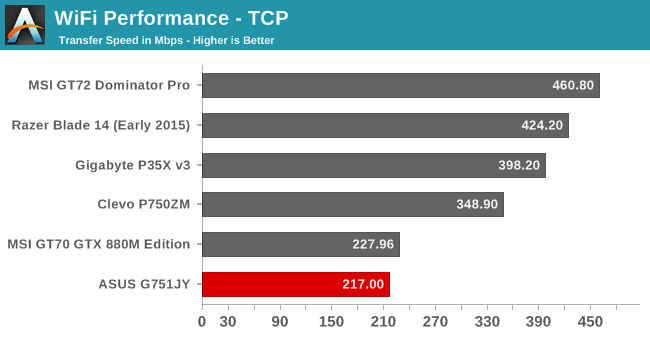
The Intel solution has never been one of the fastest out there, and in the case of the ASUS G751 I achieved even lower bandwidth scores that I would typically see out of this card. Out of the box, ASUS is using a drive from June 2014, but upgrading to the latest driver from Intel did not really help. If you do need better performance, the G751 does have a Realtek Gigabit Ethernet port on it, which I was able to get about 800 Mbps out of.
Audio
The ASUS G751 has two speakers at the rear of the device which are not visible, and appear to be coming out of the rear exhaust vent. It also has a subwoofer on the bottom to help out on the low end. It also has a SPDIF 3.5mm jack to allow it to be connected to external speakers. The audio software solution is fairly basic, with some reverb effects and an equalizer available.
Sound output was right around 80 dB, which is generally plenty of volume for most use cases. Frequency response is OK, and the included subwoofer does make a difference, although it is still a far cry from a dedicated speaker setup.
Cooling and System Noise
On a gaming laptop like this, cooling may be one of the most important factors of all. With the most powerful single notebook GPU under the hood, and a 47 watt processor, the system needs to expel all of that heat without sounding like a jet engine at takeoff. The ASUS G751 has two exhaust fans at the rear, with one for the CPU and one for the GPU. There are three heat pipes to transfer the heat out to the fans as seen in this graphic from ASUS.
To see how the system performs when doing what it is meant to be doing, I loaded up Tomb Raider set on Ultra, which will max out the GPU. This was left for about an hour or so in order to see how the cooling system performs over time.
The cooling system has no issue keeping up with the demands of the GPU, with a maximum temperature of just 72°C over the hour. The GPU frequency is maxed out for the duration, so there is no throttling going on. But even with this excellent cooling, the system fan noise was not overbearing in the least. I measured 45.2 dB with the sound meter an inch over the trackpad, which is a pretty decent result when the sound floor in my office is 36 dB. I wish I could measure the sound frequency as well, but the fans are sufficiently large to keep the frequency low and unobtrusive.
The G751 is edged out in system cooling by the MSI GT72 which kept the GPU closer to 60°C, but 72° from the G751 is perfectly acceptable with a 100% GPU load which Tomb Raider provides. And it does this without generating excessive fan noise, or high temperatures on the laptop casing itself. I don’t have a thermal camera (yet) but my IR thermometer showed a maximum temperature of 37°C at the hinge end of the device, with the keyboard and trackpad area staying very close to ambient, which is about 24°C in my testing environment.
Software
ASUS has taken a pretty light touch on the software side, which is certainly appreciated. There is a bit of extra software included which is worth discussing though, starting with the XSplit Gamecaster software which is pre-installed, and even has a dedicated button to start live game streaming. ASUS provides an unlimited recording license with the laptop, and the XSplit software supports all of the major streaming services including Twitch and YouTube, and it also allows saving the gameplay footage to your hard drive if you want to edit it before uploading, or just to keep it for historical reference.
It also offers customization to what overlays are displayed, and if you hook up a support capture card you can even use it to stream other events such as your console, although both the PlayStation 4 and Xbox One support live game streaming out of the box. For the group of people that are in to game streaming (sadly I don’t count myself in this group) this is a nice value add on the G751.
ASUS also includes their Game Center software, and it can be accessed with a dedicated button as well, which is in place of the standard Number Lock on the number pad. It offers quick access to many of the utilities including NVIDIA’s GeForce Experience software. It is also the quickest way to access ASUS’s Splendid Color application.
Splendid Color offers three presets, with Normal, Vivid, and Theater modes, and there is also a preset for a custom mode that you can configure yourself. I like these preset options from the manufacturers, as it gives the end user an easy way to adjust the display. But since I’ve been comparing the ASUS to the MSI GT72 as a direct competitor, I do like the extra option in the MSI version of this software which allows a higher gamma which is useful when playing a very dark game.
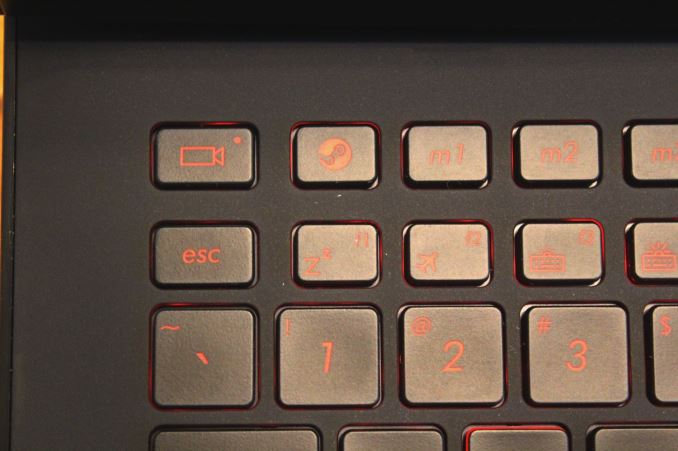 Macro, Steam, and Game Streaming keys
Macro, Steam, and Game Streaming keys
Included software is generally added for either differentiation, or to increase margins (read bloatware), and ASUS has taken the approach to include useful applications. The game streaming add-on is always something you could add yourself, but for those that are into this, it’s nice to see it included, and with a dedicated keyboard button to launch it too. The combination of software and hardware is well done, and things like ASUS including three macro keys and the necessary software really display the focus on gaming with this machine.



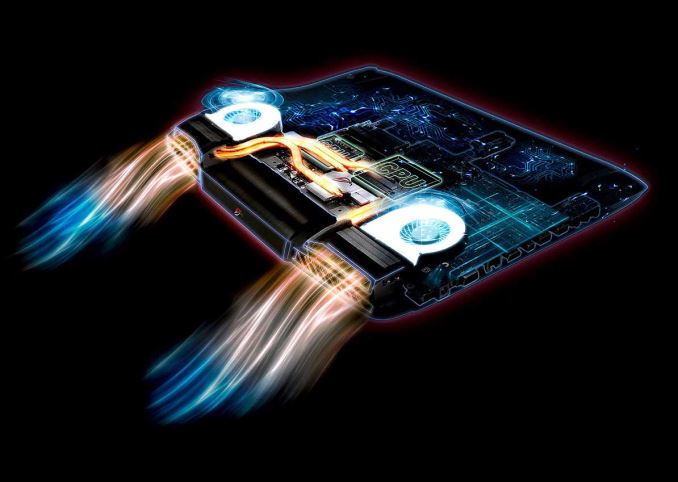
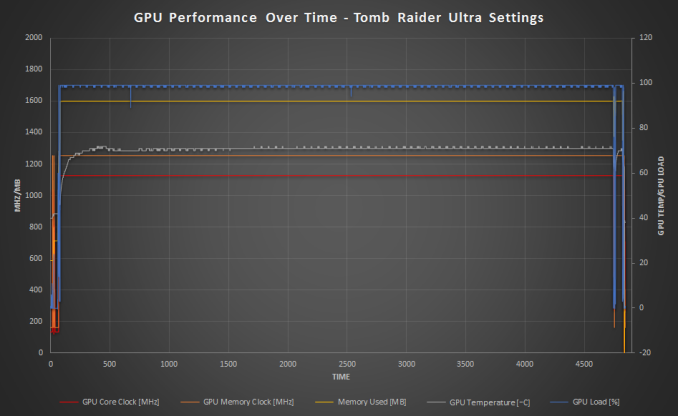

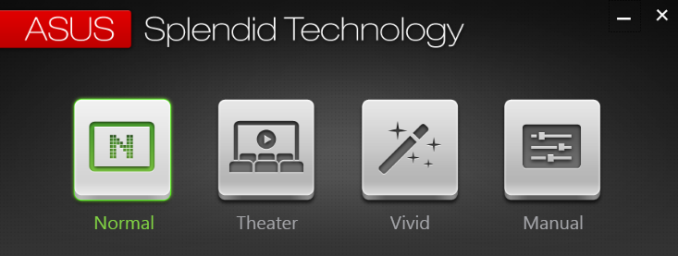








52 Comments
View All Comments
nathanddrews - Wednesday, July 29, 2015 - link
Does Intel plan on taking advantage of the Adaptive Sync tech anytime soon? I know they use it for other things for power saving (self-refresh, etc.), but it sure seems like a golden opportunity.In the same vein - given that we know (and have known for some time) that the G-Sync module is not required if you have eDP/DP1.2a, when can we expect a shift to tech-agnostic displays? Do we have to wait for DP1.3?
DanNeely - Wednesday, July 29, 2015 - link
I know eDP/DP1.2a provides a similar feature set to G-Sync; but has nVidia actually said anything about adopting it instead of (in addition to?) their current custom hardware implementation?DanNeely - Wednesday, July 29, 2015 - link
I suppose I deserve what I get for commenting before reading the 2nd page of the article; but as long as they're requiring additional qualification work to approve a panel for GSync, there's still plenty of potential to cause trouble for cross GPU support if they wanted to.nathanddrews - Wednesday, July 29, 2015 - link
VESA's Adaptive Sync is a part of eDP and DP 1.2a+. It's there, waiting to be used. G-Sync, FreeSync, and whatever Intel does are just the names for how they utilize it.The only reason NVIDIA pursued a custom module was because no desktop monitors - at the time - included A-Sync. Screens connected via eDP can. As we move forward with newer and newer displays, we're likely to see more and more of them be A-Sync-capable, which means being able to support any variable refresh technology, whatever the marketing label is. Whether or not those displays end up as G-Sync, FreeSync, or some sort of hybrid is up to the manufacturers, I suppose. Just like with G-Sync and FreeSync displays, optimizing the display will still be important.
Ideal situation: connect monitor to computer, GPU drivers load a default profile based upon EDID for frequency range and resolution support, advanced users can tweak (under/overclock/etc.), maybe share firmware, etc. to crowd-source calibration settings. Shipping a monitor back to a manufacturer for an update is ridiculous...
lefty2 - Thursday, July 30, 2015 - link
> The only reason NVIDIA pursued a custom module was because no desktop monitors - at the time - included A-Sync.This is not true. When AMD created FreeSync the DisplayPort 1.2a monitors did not exist either, but instead of creating a propierty solution, they got FreeSync incorperated into the open standard. Nvidia could have done the same thing, but they prefer using propierty standards to lock the customers in.
nathanddrews - Thursday, July 30, 2015 - link
Interesting version of history you've created.DP1.2a display availability lagged behind G-Sync Module display availability by more than a year. If NVIDIA pursued the VESA solution, G-Sync would have been delayed alongside FreeSync. The G-Sync module was absolutely required to get a jump on the market since DP1.2 did not include the Adaptive Sync option. You may not LIKE it, but that's the how it happened.
lefty2 - Thursday, July 30, 2015 - link
DP1.2a display availability also lagged behind FreeSync... AMD just waited had to wait for them to come available (in fact they pushed the standard forward) and Nvidia could have done the same.LoganPowell - Friday, November 27, 2015 - link
ASUS does overall make fantastic computers, but I'd recommend going for the Dell Inspiron i7559-763BLK. Highly approved by many gaming enthusiasts. /Logan from http://www.consumerrunner.com/top-10-best-laptops/Creig - Thursday, July 30, 2015 - link
"additional qualification" = give us money to use the G-sync name.Shadowmaster625 - Wednesday, July 29, 2015 - link
I have a great idea. Let's build Optimus notebooks for five years, and then all the sudden build one without it! Isnt that a great frickin idea? I need to be CEO of Asus.